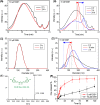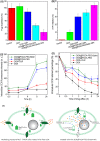A nanoparticulate pre-chemosensitizer for efficacious chemotherapy of multidrug resistant breast cancer
- PMID: 26875787
- PMCID: PMC4753478
- DOI: 10.1038/srep21459
A nanoparticulate pre-chemosensitizer for efficacious chemotherapy of multidrug resistant breast cancer
Abstract
Small-molecule chemosensitizers can reverse cancer multidrug resistance (MDR), thus significantly improving the in vitro effect of chemotherapy drugs for MDR cancer cells, however, their in vivo effects are not always very good, because they are difficult to effectively accumulate in tumor and enter the same cancer with chemotherapy drugs after systemic administration due to individual biopharmaceutical properties. To overcome these limitations, here we study a novel nanoparticular pre-chemosensitizer which can be also used as nanocarrier of chemotherapy drugs. We take an 'all in one' approach to develop a self-assembled nanoparticle formula of amphiphilic poly(curcumin-dithiodipropionic acid)-b-poly(ethylene glycol)-biotin. The nanoparticle is capable of tumor-targeted delivery, responsive degradation at the intracellular level of glutathione and subsequent intracellular co-release of the chemosensitizer curcumin and the encapsulated chemotherapeutic drug doxorubicin to maximize a synergistic effect of chemosensitization and chemotherapy. We demonstrate that the antitumor efficacy of nanoparticle is much superior to that of doxorubicin in the multidrug resistant MCF-7/ADR xenografted nude mice.
Figures






Similar articles
-
Quercetin and doxorubicin co-encapsulated biotin receptor-targeting nanoparticles for minimizing drug resistance in breast cancer.Oncotarget. 2016 May 31;7(22):32184-99. doi: 10.18632/oncotarget.8607. Oncotarget. 2016. PMID: 27058756 Free PMC article.
-
Amphiphilic Copolymeric Micelles for Doxorubicin and Curcumin Co-Delivery to Reverse Multidrug Resistance in Breast Cancer.J Biomed Nanotechnol. 2016 May;12(5):973-85. doi: 10.1166/jbn.2016.2231. J Biomed Nanotechnol. 2016. PMID: 27305819
-
Reversing of multidrug resistance breast cancer by co-delivery of P-gp siRNA and doxorubicin via folic acid-modified core-shell nanomicelles.Colloids Surf B Biointerfaces. 2016 Feb 1;138:60-9. doi: 10.1016/j.colsurfb.2015.11.041. Epub 2015 Nov 25. Colloids Surf B Biointerfaces. 2016. PMID: 26655793
-
MDR in cancer: Addressing the underlying cellular alterations with the use of nanocarriers.Pharmacol Res. 2017 Dec;126:2-30. doi: 10.1016/j.phrs.2017.07.023. Epub 2017 Jul 29. Pharmacol Res. 2017. PMID: 28760489 Review.
-
Nano-drug delivery system for the treatment of multidrug-resistant breast cancer: Current status and future perspectives.Biomed Pharmacother. 2024 Oct;179:117327. doi: 10.1016/j.biopha.2024.117327. Epub 2024 Aug 30. Biomed Pharmacother. 2024. PMID: 39216449 Review.
Cited by
-
Orthogonal self-assembly of an organoplatinum(II) metallacycle and cucurbit[8]uril that delivers curcumin to cancer cells.Proc Natl Acad Sci U S A. 2018 Aug 7;115(32):8087-8092. doi: 10.1073/pnas.1803800115. Epub 2018 Jul 23. Proc Natl Acad Sci U S A. 2018. PMID: 30038010 Free PMC article.
-
Phytochemical Targeting of Mitochondria for Breast Cancer Chemoprevention, Therapy, and Sensitization.Int J Mol Sci. 2022 Nov 16;23(22):14152. doi: 10.3390/ijms232214152. Int J Mol Sci. 2022. PMID: 36430632 Free PMC article. Review.
-
Drug Resistance in Metastatic Breast Cancer: Tumor Targeted Nanomedicine to the Rescue.Int J Mol Sci. 2021 Apr 28;22(9):4673. doi: 10.3390/ijms22094673. Int J Mol Sci. 2021. PMID: 33925129 Free PMC article. Review.
-
Achillin Increases Chemosensitivity to Paclitaxel, Overcoming Resistance and Enhancing Apoptosis in Human Hepatocellular Carcinoma Cell Line Resistant to Paclitaxel (Hep3B/PTX).Pharmaceutics. 2019 Oct 4;11(10):512. doi: 10.3390/pharmaceutics11100512. Pharmaceutics. 2019. PMID: 31590262 Free PMC article.
-
Size-Controlled Preparation of Docetaxel- and Curcumin-Loaded Nanoemulsions for Potential Pulmonary Delivery.Pharmaceutics. 2023 Feb 15;15(2):652. doi: 10.3390/pharmaceutics15020652. Pharmaceutics. 2023. PMID: 36839974 Free PMC article.
References
-
- Vakoc C. R., Garcia-Manero G. & Look A. T. Cancer Therapy Resistance: Chasing Epigenetics. Nat. Med. 20, 340–341 (2014). - PubMed
-
- Holohan C., Van Schaeybroeck S., Longley D. B. & Johnston P. G. Cancer Drug Resistance: An Evolving Paradigm. Nat. Rev. Cancer 13, 714–726 (2013). - PubMed
-
- Lee P. C. et al.. Multidrug-Resistant Cells Overexpressing P-Glycoprotein are Susceptible to DNA Crosslinking Agents due to Attenuated Src/nuclear EGFR Cascade-Activated DNA Repair Activity. Oncogene 32, 1144–1154 (2013). - PubMed
Publication types
MeSH terms
Substances
Grants and funding
LinkOut - more resources
Full Text Sources
Other Literature Sources
Medical
Research Materials

